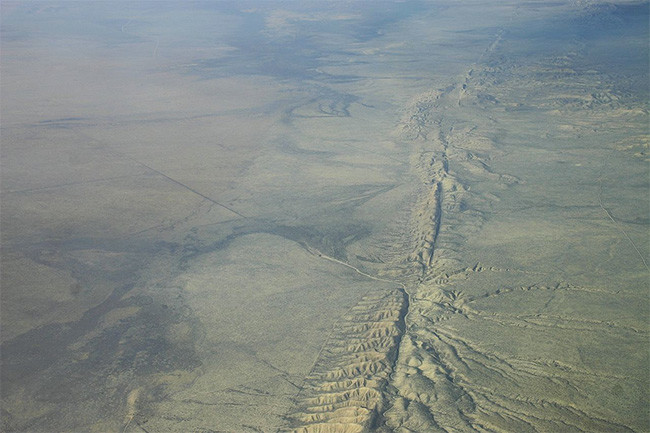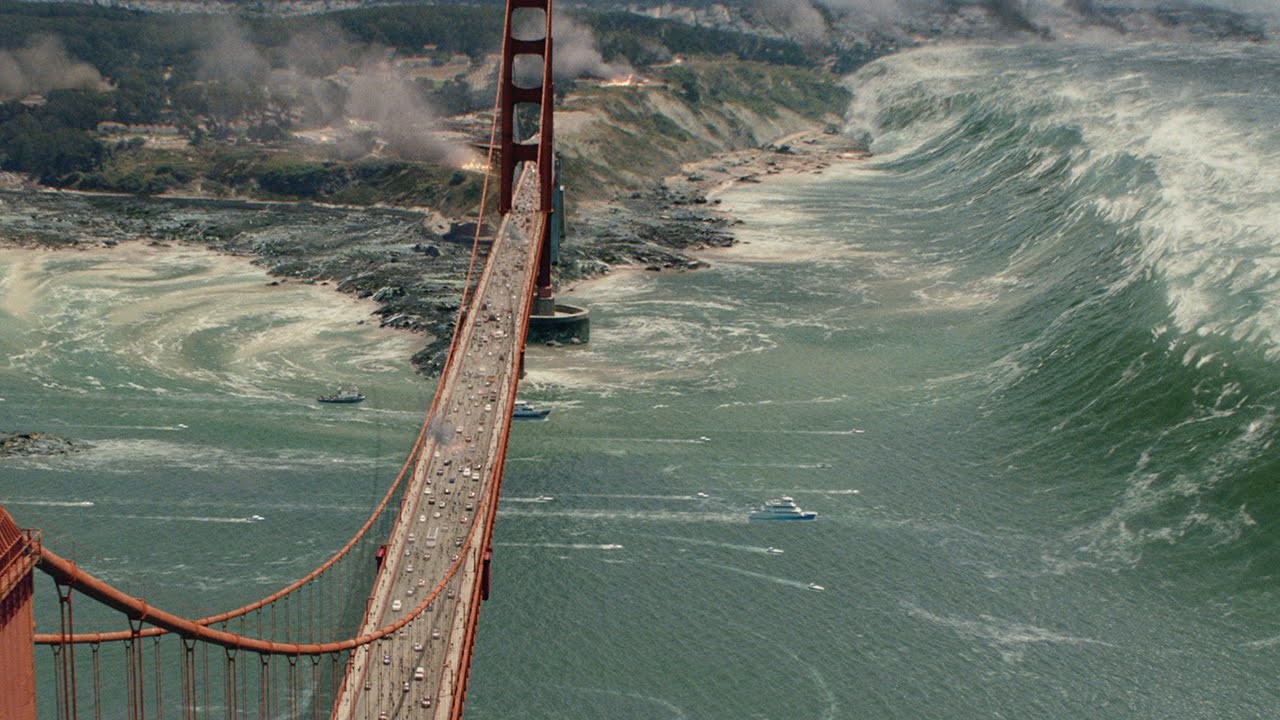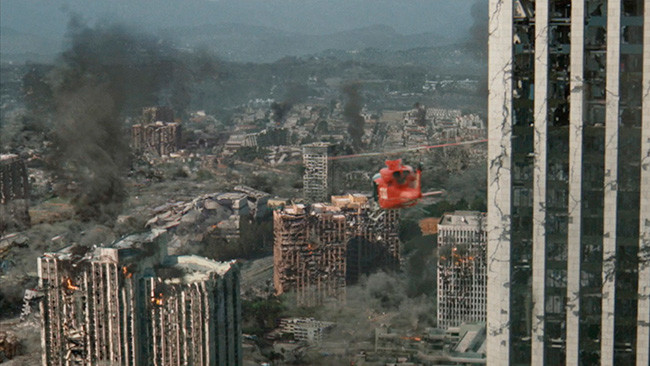A 7.1-magnitude earthquake is a prelude to much larger ones that split the land that sits on the San Andreas Fault in California (USA) in two, destroying several cities. No, don’t be alarmed yet, since it is the story from which ‘San Andrés’ starts, a new film about natural disasters that hits Spanish cinemas today. But how much is real and how much is fiction in his argument? Is there any chance of this happening?
The San Andreas fault

The planet’s crust is fragmented into what we know as tectonic plates, blocks of rigid earth that drift along the planet’s outer mantle. There are 15 large plates (and more than 40 smaller ones) whose edges are areas of great seismic activity. We have already seen the case of Chile due to the subduction zone (one plate penetrates under another plate) formed between the Nazca plate and the South American plate.
If instead of talking about a vertical movement (one over the other) we talk about a horizontal movement, and more specifically when two plates move laterally in parallel but in different directions, this is when transform fault zones are generated. Although they do not generate or destroy the lithosphere, they are also a common source of earthquakes. San Andreas, in the United States, is one of the best-known thanks to its more than 1,300 kilometers long.
As can be seen on the map, the Pacific plate (at the bottom) is in contact with the North American plate (at the top), generating a contact zone. The plates rub against each other laterally (the arrows indicate the direction of movement of each one) and accumulate energy. “The degree of slippage of the faults, and therefore of the blocking, controls the size and timing of large earthquakes in the system,” said James Lienkaemper, a member of the Seismological Society of America and author of a study. about how energy accumulates in said fault.
According to Lienkaemper himself, 60% of the energy in faults is released through slippage (between 0.1 and 25 mm per year) and 28% is retained in the depths of the fault. In its research, the Seismological Society of America estimates that there are three faults in the area that have accumulated enough energy to produce an earthquake and another that, due to medium recurrence, should suffer an earthquake soon.
Seismic recurrence? Yes: A study of the earthquakes that have occurred historically in a certain area can indicate whether another earthquake is expected to occur shortly. The mathematical expression that allows this to be calculated is known as the Gutenberg-Richter Law.
In the case of San Andrés, some seismologists have been talking for years about what is known as The Big One, a hypothetical mega-earthquake of magnitude 8 or higher that would hit California. Last March, the US Geological Survey warned that the risk of an earthquake of this nature occurring over the next 30 years had risen from 4.7% in 2008 to 7% today. According to this same institution, an earthquake of these characteristics in the United States could cause 1,800 deaths, 50,000 injuries, and more than 200,000 million dollars in damage.
However, The Big One is still a hypothetical earthquake. At present, there are no sufficiently reliable systems to accurately predict earthquakes, although for many scientists it is an unavoidable earthquake. It is not known when it will happen, but it is known that it will happen. Because? Because there have been no major earthquakes on the southern part of the San Andreas Fault in years, the stress is building up and there will come a time when it is suddenly released in the form of an earthquake.
What do the experts say about the film?
Ok, Los Angeles (and all of California) is an area of high seismic risk and it even seems quite accepted within the scientific community that at some point they will suffer a megaquake again. So far, reality quite coincides with the plot of the film. But what about the rest of the things we see in it? It is best that you first take a look at the trailer to see what the story is about:
First of all, and according to the experts, all the simulations carried out so far conclude that the San Andreas Fault can produce earthquakes of up to magnitude 8.3, and not 9 or more as shown in the movie. The fault is not large or deep enough to accumulate such levels of energy. And, although it seems like a matter of simple decimals, it is not: in the Earthquake Country Alliance they explain how an earthquake of magnitude 9.6 would be 90 times more intense than an earthquake of 8.3.
But would such a strong earthquake manage to split a surface into two separate parts, as shown in the trailer and the image with which we opened this article? No. Emel Seyhan, an engineer specializing in seismology, defines the problem in one sentence: the crack is “too long, too wide, and too deep”. Let’s remember that on the San Andreas Fault, the plates rub against each other, so it doesn’t make sense for them to suddenly separate. They are not moving in that direction. If the fault were to open like this, there would be no friction and therefore no earthquake.
And what about the tsunami? Large earthquakes can be accompanied by their respective tsunami, but this occurs only in subduction zones when the earthquake originates in underwater areas. The San Andreas Fault is not underwater, as Thomas Jordan (director of the Southern California Earthquake Center) points out, and, being a vertical fault, it has no way of moving the ocean up and down. In addition, in the film, a giant wave is seen sweeping the Golden Gate. Therefore, the tsunami should reach more than 80 meters high, when the normal thing is that the height of these phenomena does not exceed, in the worst case, 15 meters.

Other details mentioned in the movie don’t add up either. Contrary to what they indicate there, currently earthquakes cannot be predicted by studying electromagnetic signals. Tiziana Rossetto, professor of earthquake engineering at University College London, explains that the only thing that can be done for now is “probabilistic estimates”, that is, “to say that in the next 10 years, there is going to be an earthquake of a certain magnitude”. And, to reach this conclusion, seismologists study the history of seismological events in the area and the state of the local faults.
Rossetto also affirms that “chaos and destruction are exaggerated”, something that other experts also agree, such as structural engineer Farzad Naeim: “There will be destruction, collapses and deaths, but buildings will fall very rarely”. Especially if we talk about modern buildings, which are more prepared to withstand tremors. In addition, and the opinion of Thomas Jordan, they minimize other possible problems that would play a major role in such an event, such as fire. According to estimates from the United States Geological Survey, a magnitude 8 earthquake would generate more than 1,600 sources of fire in Los Angeles alone.

We are talking about a movie, and the spectacularity and the drama prevail, but is there anything realistic or positive that can be taken from it? Lucy Jones, a seismologist at the United States Geological Institute, comments in an article that the most credible thing in the whole story is the human reaction to the disaster and, in addition, it represents the danger of earthquakes, shows the importance of being prepared and teaches some basics (such as the famous ” Drop, Cover, Hold On “) on how to react to them. Not everything was going to be negative, right?

Sharlene Meriel is an avid gamer with a knack for technology. He has been writing about the latest technologies for the past 5 years. His contribution in technology journalism has been noteworthy. He is also a day trader with interest in the Forex market.






